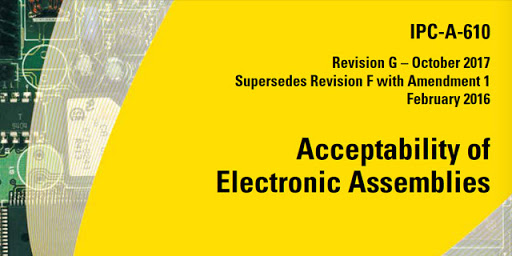IPC standards for PCB design
What is IPC

Institute Of Printed Circuits, founded in 1957, is one of the most influential organizations in the electronics manufacturing industry in the United States and even the world. It was renamed “Association Of Connecting Electronics Industries” in 1999, but the mark and abbreviation, IPC, remained unchanged.
IPC, as a global industry organization, is committed to enhancing the competitiveness of member companies and helping them achieve commercial success. Specifically, IPC will be committed to more advanced management methods, more advanced technology, formulation of industry-related standards, promotion of environmental protection, and related government relations.
What is the IPC standard

IPC has developed thousands of standards and specifications. Here we introduce some of the more widely adopted standards for electronic products.
IPC-A-610
The purpose of IPC-A-610, Acceptability of Electronic Assemblies, is to help manufacturers achieve the highest SMT production quality. It is widely recognized in the electronics manufacturing industry and can be used as an internationally accepted quality inspection standard. The A-610-E version was released in 2010, and the A610-G version was released in 2017.

The IPC-A-610 standard divides electronic products into 3 levels according to the reliability requirements and use conditions of electronic products.
1.General Electronics: Its purpose is to target consumer appliances, that do not require high-performance requirements and focus on functional requirements.
2.Dedicated Service Electronics: This type of product requires a long life, but it is not required to maintain uninterrupted operation, and defects in appearance are also allowed, including communication equipment, complex business machines, high-performance, and long-life equipment.
3.High-Performance Electronics: There should be no interruption in the use of such products, including equipment and products that operate continuously or strictly in accordance with strict guidelines, such as medical lifesaving, flight control, precision measuring instruments, and high-reliability products that are used in harsh environments.
For products at all levels, IPC-610 specifies acceptance conditions such as “target conditions”, “acceptable conditions”, “process indicator conditions” and “defect conditions”.
① Target Condition: It refers to nearly perfect or optimal conditions. This is an ideal condition but is not always necessary.
② Acceptable Condition: It means that the assembly can ensure complete and reliable operation under the environment in which it is used, but it is not perfect.
③ Process Indicator Condition: It refers to a situation that may indicate a defect but does not affect the integrity, installation, and function of the product. This is caused by materials, design, operation, equipment, process parameters, etc.
④ Defect Conditions: It means that the assembly may not meet the requirements in terms of completeness, installation, or function. This kind of product can be reworked, repaired, scrapped, or “disposed of according to regulations” according to design, service, and user requirements, among which “disposal according to regulations” must be approved by users.
Others
IPC-6011: Generic Performance Specification for Printed Boards. This specification serves as the basis for the IPC-6010 printed board performance series specifications, establishing general requirements and responsibilities for printed board suppliers and users. It describes the quality and reliability assurance requirements that must be met, and is used in conjunction with IPC-6012~IPC6018.
IPC-2581: Generic Requirements for Printed Board Assembly Products Manufacturing Description Data and Transfer Methodology. This standard specifies the XML schema that represents the intelligent data file format used to describe printed board and printed board assembly products with details sufficient for tooling, manufacturing, assembly, and inspection requirements.
IPC-D-275: Design Standard for Rigid Printed Boards and Rigid Printed Board Assemblies. This standard establishes requirements and other considerations for the design of rigid printed boards and printed board assemblies.
IPC-SM-9701: Performance Test Methods and Qualification Requirements for Surface Mount Solder Attachments. This standard establishes a clear experimental method to evaluate the performance and reliability of surface mount solder joints in electronic assembly. Through testing, the performance and reliability of surface mount solder joints on rigid circuit boards, flexible circuit boards, and semi-rigid circuit boards can be divided into different levels.
IPC-2221: Generic Standard on Printed Board Design. This standard is intended to provide information on the generic requirements for organic printed board design. All aspects and details of the design requirements are addressed to the extent that they can be applied to the broad spectrum of those designs that use organic materials or organic materials in combination with inorganic materials (metal, glass, ceramic, etc.) to provide the structure for mounting and interconnecting electronic, electromechanical, and mechanical components.
IPC-J-STD-001: Requirements for Soldered Electrical and Electronic Assemblies Training and Certification Program. IPC J-STD-001, Requirements for Soldered Electrical and Electronic Assemblies, has emerged as the preeminent authority for electronics assembly manufacturing worldwide. The standard describes materials, methods and verification criteria for producing high-quality soldered leaded and lead-free interconnections. It emphasizes process control and establishes industry consensus requirements for a broad range of electronic connections.
Why use IPC standards
IPC standards control the quality and reliability of the final product:
Quality and reliability are the cornerstones of maintaining market competitiveness and are also vital to the company’s reputation and profitability. Through the implementation of IPC standards throughout the production process, the company’s products have better performance and longer service life.
Improve communication with suppliers and company employees:
IPC standards are common standards used by company competitors, suppliers, and EMS manufacturers. In work, an existing IPC standard can become everyone’s “common language”-the language of the global electronics industry. In addition, the use of IPC standards can eliminate the confusion of employees, because they know the standard requirements that their work needs to meet.
Help control costs:
If the design and the purchased bare board meet the IPC standard, and the production process and quality control also follow the IPC standard, then your production will be able to minimize delays, rework and scrap.
In addition to the standards mentioned above, there are more standards on every aspect of PCB, and this article will not describe them one by one.
The services provided by Seeed Fusion meet IPC standards. Please rest assured that the quality of the products processed by Seeed will definitely be great.
